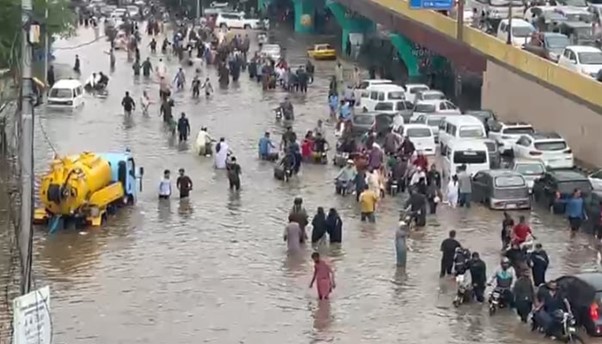KARACHI: The Sindh government has declared Wednesday, August 20, a public holiday after Karachi rains wreaked havoc across the city. Heavy downpours submerged streets, flooded homes, and caused at least 10 deaths in electrocutions, drownings, and wall-collapse incidents.
Power cuts hit several areas. Internet and mobile services also went down. Gulshan-e-Hadeed reported the highest rainfall at 170mm, according to the Met Office.
Officials advised residents to avoid unnecessary travel. Many people returning from schools and offices were stranded as water rose several feet in low-lying areas, including Malir. The scenes were grim, reminding citizens of the catastrophic 2022 floods.
Intermittent torrential rains lashed Karachi throughout the day. Several neighborhoods — Gulshan-e-Hadeed, Korangi Crossing, Liaquatabad, Baldia Town, Rafah-e-Aam, and Shah Faisal Colony — reported water inside homes. In North Karachi and Malir, water levels climbed to four feet. Stranded residents abandoned vehicles and waded through waist-deep water.
Traffic jams choked main arteries. Sharea Faisal, University Road, and II Chundrigar Road were clogged. Long queues formed on Nagan Chowrangi, Hub River Road, and Miran Naka. Vehicles broke down on waterlogged streets, leaving commuters stuck for hours.
Low-lying neighborhoods such as Surjani Town, Shadman Town in North Nazimabad, and large parts of District Malir were inundated.
Rescue officials reported that three people, including two women, drowned in a stormwater drain near Guru Mandir. Two women were pulled out alive, while the search for another victim was still underway. Four people were killed and two injured in Gulistan-e-Jauhar after a house wall collapsed. In Orangi, a child lost his life in a similar accident.
Rain-related electrocutions added to the tragedy. A motorcyclist was electrocuted near Nursery on Sharea Faisal. Another man riding in Defence Housing Authority (DHA) died after receiving an electric shock from standing water.
The death toll from the heavy rainfall in Karachi rose to 10 by nightfall.
Met Office Warning
A spokesperson for the Met Office warned that the next two days remain critical. More monsoon showers are expected on August 20 and 21. Gulshan-e-Hadeed received the highest rainfall of 170mm, followed by Airport Old Area (158.5mm), Jinnah Terminal (152.8mm), Nazimabad (149.6mm), and Surjani Town (145.2mm).
Flights Disrupted
The downpour disrupted flight operations at Jinnah International Airport. At least eight flights were cancelled, while 20 others were delayed. Several incoming flights were diverted.
PIA’s flight PK-456 from Skardu was rerouted. A Flydubai flight from Dubai (FZ-335) landed in Multan instead of Karachi. PIA also cancelled flights PK-310 and PK-311 (Karachi-Quetta) and PK-308 and PK-309 (Karachi-Islamabad). Sukkur-bound flights PK-536 and PK-537 were scrapped.
Delays hit flights from Jeddah, Sharjah, Abu Dhabi, Colombo, Medina, Peshawar, and Toronto, with wait times ranging from one to five hours.
Rain Emergency Declared
Sindh Chief Minister Murad Ali Shah activated the Rain Emergency Plan. He directed officials to clear waterlogged roads and drain low-lying areas. Sindh Home Minister Ziaul Hassan Lanjar also asked police to focus on citizens’ safety and advised people to avoid unnecessary travel.
Governor Kamran Tessori established a Rain Emergency Cell at Governor’s House. Mayor Murtaza Wahab confirmed that Karachi received over 100mm of rain, which is far beyond the city’s 40mm drainage capacity.
Speaking to the media, Wahab said that 3.024 million cubic feet of debris had been removed from storm drains, helping water flow. But he admitted the drainage system has major flaws. He stressed that storm drains must be cleaned regularly to prevent flooding in Karachi.
He noted that resistance from residents blocks efforts to expand drainage. “Basic steps are needed to increase capacity,” he added. Wahab confirmed receiving complaints of power outages in several areas but claimed overall traffic flow improved by evening.
Governor on the Ground
Governor Tessori personally visited rain-hit areas. He was seen helping motorists push vehicles through flooded roads. He announced that Governor’s House would stay open at night to shelter affected citizens. A helpline (1366) has been set up for those needing assistance.
Despite efforts, Red Zone areas remained submerged the next morning. Waterlogging was still reported around Aiwan-e-Sadr and Dr Ziauddin Ahmed Road. Roads leading to the Governor’s House and Police Lines also stayed flooded, making movement difficult.
Public Holiday Declared
CM Shah announced a public holiday on August 20 to protect citizens from further hardship. An official notification confirmed the holiday for Karachi Division, excluding essential services. The public was advised to remain indoors.
More Heavy Rains Ahead
The Met Office forecast strong monsoon currents from the Arabian Sea and Bay of Bengal. Widespread showers are expected from August 19-22 across Sindh. Districts including Karachi, Thatta, Badin, Hyderabad, Sajawal, Sanghar, Tando Allayar, Mirpurkhas, and Jamshoro are likely to face heavy rainfall.
Torrential rains may cause more urban flooding in Karachi.
K-Electric said power supply from 1,770 feeders out of 2,100 remained intact. Temporary shutdowns in waterlogged areas were safety measures. KE urged citizens to stay away from poles, meters, wires, and wet electrical setups.
Deaths Across Pakistan
Monsoon rains have battered other provinces as well. Nationwide, rain-related deaths have reached 660. Khyber Pakhtunkhwa reported the highest toll with 392 deaths, followed by Punjab (164), Gilgit-Baltistan (32), Sindh (29), Balochistan (20), Azad Jammu and Kashmir (15), and Islamabad (8).
Among the dead were 394 men, 95 women, and 171 children. At least 935 people have been injured. Punjab recorded the highest number of injuries at 582. KP reported 245 injured, Sindh 40, GB 37, AJK 24, Balochistan four, and Islamabad three.
The Karachi rains have once again exposed the fragility of urban infrastructure, leaving citizens fearful of the next downpour.

